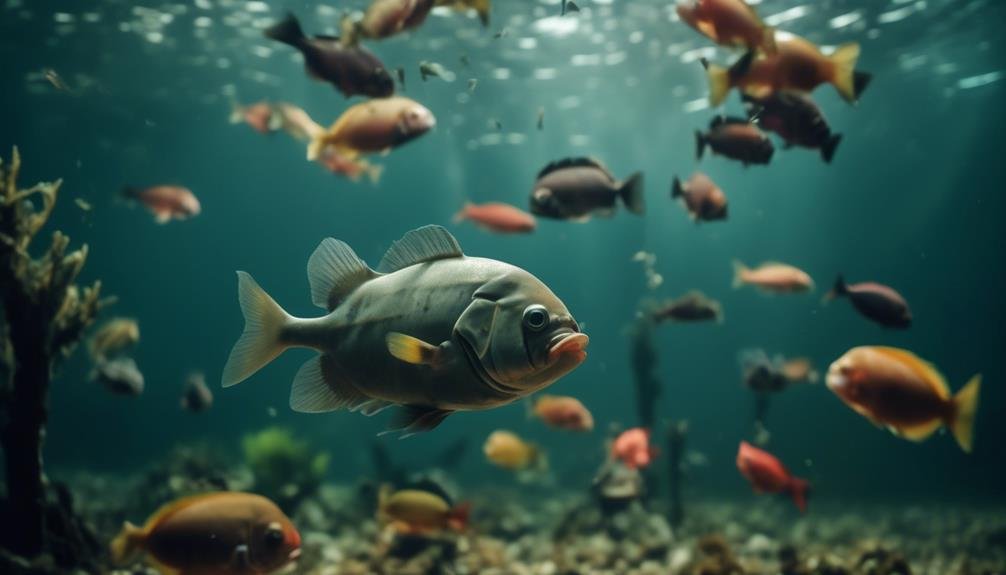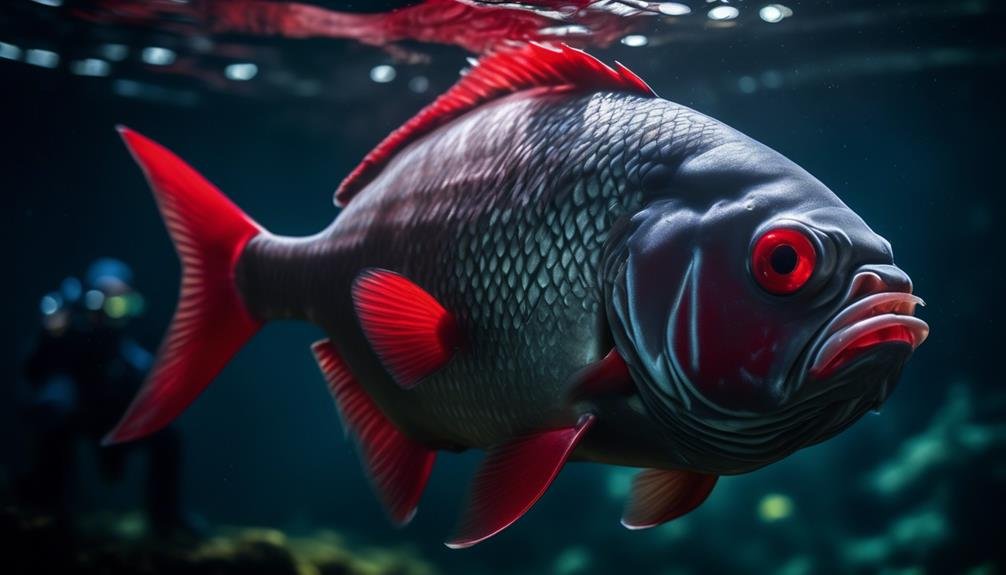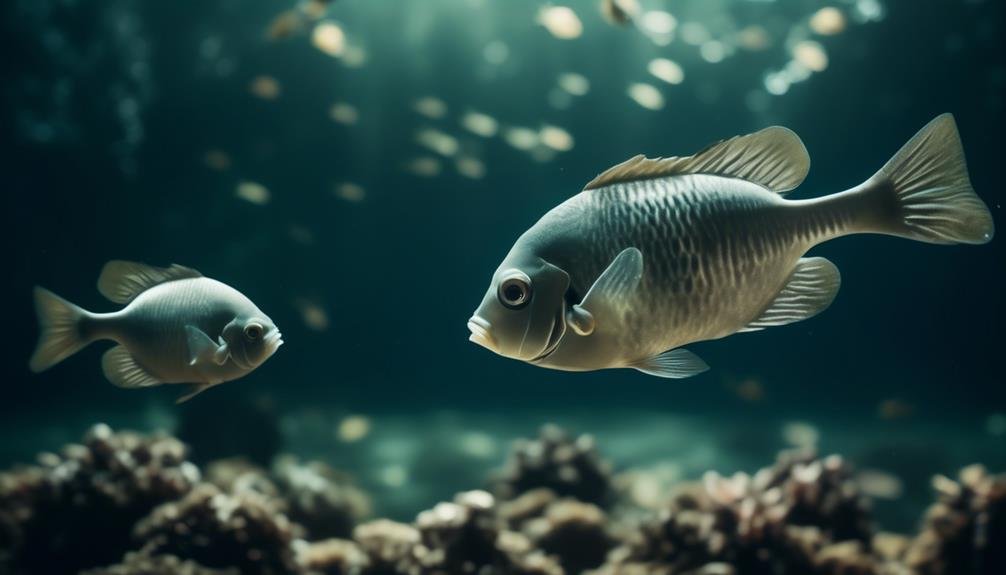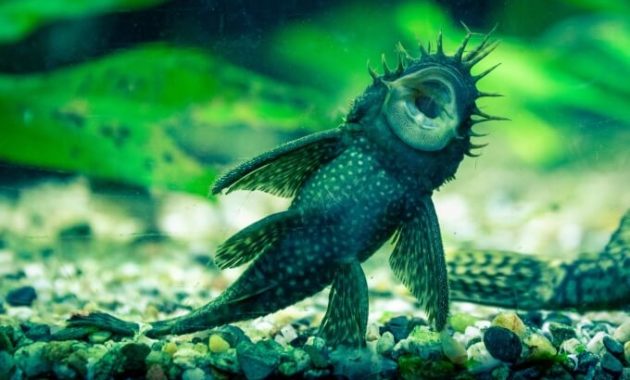
Have you ever marveled at the beauty of a vibrant underwater ecosystem, only to discover that it is under threat from an unlikely source? Enter the Pacu fish, a seemingly harmless freshwater species that has become an invasive menace in various parts of the world.
While they may resemble their notorious cousin, the Piranha, these herbivorous creatures have a unique set of characteristics that make them both fascinating and dangerous. From their square-shaped, human-like teeth to their ability to recognize their owners, Pacu fish have captured the attention of many.
However, their captivating traits come at a cost, as their illegal release has led to a widespread invasion that disrupts the delicate balance of ecosystems.
So, buckle up and prepare to explore the intriguing world of Pacu fish and the ripple effects they have on our environment.
Key Takeaways
- Pacu fish are freshwater herbivores related to piranhas, known for their square-shaped teeth and ability to grow over 30 inches long.
- They are native to South America but have been illegally released and become invasive species in some areas, posing a threat to the ecosystem.
- Pacu fish have a dull appearance compared to colorful tropical fish, with greyish olive scales and accent colors varying based on the species.
- Proper care and maintenance of pacu fish require large aquariums or outdoor ponds, and their feeding habits include a varied diet of seeds, nuts, plants, and small fish, with complex nutritional needs as they grow older.
Pacu Fish Overview
Pacu fish, often mistaken for their carnivorous relative, the piranha, are herbivorous and peaceful freshwater fish that can grow over 30 inches long. These fish have square-shaped teeth that resemble human teeth. They can develop personalities and even recognize their owners.
Native to tropical and subtropical South America, pacu fish can be found in rivers, lakes, and flooded forests. However, some species have been illegally released and can now be found worldwide. This makes them an invasive species in certain areas, posing a threat to the ecosystem.
In terms of appearance, pacu fish have greyish olive scales with accent colors that vary based on the species. While they aren't as colorful as tropical fish, they possess a unique charm.
Pacu Fish Origins

Originally hailing from tropical and subtropical South America, these herbivorous freshwater fish have made their mark as an invasive species in certain regions. Found in rivers, lakes, and flooded forests, some species have been found worldwide due to illegal release. They are considered invasive species in some areas and pose a threat to the ecosystem. These fish can outcompete native species and disrupt the natural balance.
Pacu fish, native to the lush habitats of South America, have now spread beyond their natural range, wreaking havoc in various parts of the world. With their ability to adapt and reproduce rapidly, they pose a significant threat to the delicate balance of ecosystems.
The illegal release of these fish into non-native waters has further exacerbated the problem. Their voracious appetite for vegetation and their ability to outcompete native species for resources make them a formidable invader.
As they multiply and spread, the delicate ecological web can be disrupted, leading to the decline of native species and the loss of biodiversity.
Spread of Invasive Pacu Fish

As these invasive fish continue to spread beyond their natural range, their rapid adaptation and reproduction pose an ongoing threat to ecosystems worldwide.
Pacu fish, originally native to tropical and subtropical South America, have been found in rivers, lakes, and flooded forests. However, due to illegal release, some species have managed to establish populations in various parts of the world, making them invasive species in those areas.
This spread has resulted in significant ecological damage, as pacu fish outcompete native species for resources and disrupt the balance of aquatic ecosystems. Their ability to adapt quickly to new environments, combined with their high reproductive rates, allows them to colonize new habitats rapidly.
Without effective management and control measures, the invasive spread of pacu fish will continue to have detrimental effects on ecosystems globally.
Impact on Ecosystems

The invasive spread of the pacu fish has had significant impacts on ecosystems worldwide. These impacts can be seen in various ways, including:
- Disruption of native fish populations: Pacu fish compete with native species for resources such as food and habitat, leading to a decline in their populations.
- Destruction of aquatic vegetation: Pacu fish have a voracious appetite for plants, and their feeding habits can result in the destruction of aquatic vegetation, disrupting the balance of the ecosystem.
- Altered nutrient cycling: Pacu fish excrete waste that contains nutrients, which can cause changes in nutrient cycling in the ecosystem, affecting the growth of other organisms.
- Introduction of diseases and parasites: Pacu fish can act as carriers of diseases and parasites, which can be harmful to native species and further disrupt the ecosystem.
- Loss of biodiversity: The invasion of pacu fish can lead to a loss of biodiversity, as native species are outcompeted or displaced by the invasive species.
These impacts highlight the need for effective management strategies to control the spread of pacu fish and mitigate their negative effects on ecosystems.
Physical Characteristics of Pacu Fish

Pacu fish possess distinct physical characteristics that set them apart from other freshwater species. With their greyish olive scales, Pacu fish may appear dull in comparison to the colorful tropical fish commonly found in aquariums. However, their accent colors can vary based on the species. For instance, the Black Pacu has a mainly black body, while the Red-Bellied Pacu has a scarlet underside.
One notable feature of Pacu fish is their square-shaped, human-like teeth, which are used for crushing seeds, nuts, and plants. These teeth, along with their ability to grow over 30 inches long, make Pacu fish quite powerful and potentially damaging to aquarium accessories.
Therefore, it's essential to provide them with large aquariums or outdoor ponds to accommodate their size and inquisitive nature.
Pacu Fish Care and Maintenance

To properly care for and maintain Pacu fish, it's important to provide them with a spacious aquarium or outdoor pond that can accommodate their large size and inquisitive nature. Here are some key points to consider:
- Size matters: Pacu fish can grow over 30 inches long, so make sure you have enough space to accommodate their size.
- Watch out for those teeth: Their square-shaped, human-like teeth can damage aquarium accessories, so choose sturdy decorations.
- Curiosity can lead to trouble: Pacu fish are inquisitive and have a powerful bite. Ensure the aquarium is secure and free of any escape routes.
- Ideal living conditions: Maintain a water pH of 6.0 to 8.0 and a temperature between 75-81°F for optimal health.
- Feeding the Pacu: They're omnivores, so provide a varied diet of seeds, nuts, plants, small fish, flake or pellet food, and occasional worms as supplements.
Feeding Habits of Pacu Fish

When it comes to feeding, Pacu fish have a diverse and voracious appetite. These freshwater fish are omnivores, meaning they eat a variety of foods including seeds, nuts, plants, and small fish. Juvenile Pacu fish can be fed flakes, while adult Pacu fish require high-quality pellets.
It's important to supplement their diet with plant food and occasional worms. However, it's worth noting that Pacu fish have a tendency to devour live plants quickly. As they grow older, their nutritional needs become more complex. So, it's crucial to provide a well-balanced diet to ensure their health and well-being.
Whether it's seeds, nuts, plants, or small fish, Pacu fish will eagerly devour whatever you offer them.
Other Fish Species to Avoid

If you're looking to avoid potential issues in your aquarium, it's important to be cautious of certain fish species. Here are five fish species that you should avoid:
- Common pleco: This species requires large tanks and a specific diet.
- Arowana: Known for growing quickly, they're aggressive and need a large tank.
- Pacu: These fish can reach up to 3 feet long and have been known to eat their tank mates.
- Red Tail Catfish: They can grow up to 5 feet long and also have a tendency to eat other fish in the tank.
- Bala Sharks: While popular, they grow too large for home aquariums and need to be kept in groups.
Silver Dollar Fish: A Potential Alternative

Looking to avoid potential issues in your aquarium? Consider the Silver Dollar Fish as a potential alternative to the fish species mentioned earlier.
Silver Dollar Fish have round shaped bodies with silver coloring and originate from the Amazon River in South America. They're hardy in nature and suitable for most community aquariums. With their scale-less silver bodies, they add a unique and captivating touch to any tank.
Silver Dollar Fish are known to be peaceful and can coexist with other fish species. They're also relatively easy to care for, making them a great choice for beginners.
Oscar Fish: A Unique Freshwater Species

Oscar Fish, a fascinating and unique freshwater species, captivates aquarium enthusiasts with its thick, rectangular-shaped body and large head.
Here are five things you should know about Oscar Fish:
- Highly intelligent: Oscars are known for their high level of intelligence, which allows them to recognize their owners and even develop personalities.
- Territorial behavior: As adults, Oscar Fish can become quite territorial and aggressive, especially towards other fish. It's important to provide them with ample space and suitable tank mates.
- Vibrant color variations: Oscars come in a range of colors, including black, brown, orange, red, and albino varieties, adding a vibrant touch to any aquarium.
- Demanding care requirements: Due to their size and territorial nature, Oscars require a spacious tank with proper filtration. They're also sensitive to water quality, so regular monitoring and maintenance are crucial.
- Fascinating behavior: Oscars are known for their inquisitive nature and powerful bite. Watching them explore their environment and interact with their surroundings can be a captivating experience.
Freshwater Sharks: Fascinating Aquarium Additions

Freshwater sharks make for fascinating additions to your aquarium, offering a unique and captivating experience for aquarium enthusiasts. These sharks, belonging to the minnow family, resemble their marine counterparts and come in vibrant colors such as red, silver, white, gold, and black. Their vibrant colorations and fascinating behavior patterns make them a standout choice for any aquarium.
Originating mostly from Asia, these freshwater sharks are known for their sleek appearance and eye-catching presence. They're relatively low-maintenance and can adapt well to different water conditions. However, it's important to note that they may require larger tanks due to their active nature.
With their distinctive features and intriguing behavior, freshwater sharks are sure to be a captivating addition to your aquarium.
Arowana Fish: Exotic and Challenging Aquatic Pets

Arowana Fish, known for their exotic appearance and demanding care requirements, are a popular choice for experienced aquarium enthusiasts. These majestic creatures require special attention and expertise to thrive in captivity. Here are some key points to consider:
- Arowanas are prized for their long, sleek bodies and metallic scales.
- They come in a variety of colors, including silver, gold, and red.
- Arowanas can grow up to three feet long, requiring spacious tanks.
- They're carnivorous predators, feasting on insects, small fish, and even small birds.
- Arowanas are known for their jumping ability, so a tightly secured tank lid is essential.
Owning an Arowana can be a rewarding experience, but it requires dedication and a deep understanding of their needs. Are you ready to take on the challenge?
Frequently Asked Questions
How Big Can Pacu Fish Grow?
Pacu fish can grow over 30 inches long. They are extremely large species that require spacious aquariums or outdoor ponds. Their powerful teeth can damage accessories, and they have an inquisitive nature.
Can Pacu Fish Recognize Their Owners?
Yes, Pacu fish can recognize their owners. They have the ability to develop personalities and form connections with their caretakers. It's an interesting trait that adds to their appeal as pets.
What Are the Suitable Water Conditions for Pacu Fish?
For your Pacu fish, keep the water pH between 6.0 to 8.0 and the temperature at 75-81°F. These conditions are suitable for their well-being and help them thrive in their environment.
What Should Be Included in the Diet of Pacu Fish as They Grow Older?
As your pacu fish grow older, their diet should include a variety of foods. They are omnivores, so you can feed them quality pellets, plant food, occasional worms, and supplements. Make sure to provide complex nutrition as they mature.
What Are Some Other Fish Species to Avoid in Aquariums?
Avoid common plecos, arowanas, pacus, red tail catfish, and bala sharks in your aquarium. These species grow large, can be aggressive, and eat tank mates. Choose silver dollar fish, oscar fish, freshwater sharks, or arowanas as alternatives.
How do African Tiger Fish compare to Pacu Fish in terms of their threat to ecosystems?
The presence of African tiger fish unleashed in various ecosystems has raised concerns about their potential impact. While both African tiger fish and pacu fish are predatory, the former are known for their aggressive behavior and ability to disrupt native fish populations. Consequently, they are considered a greater threat to ecosystems than pacu fish.
Conclusion
In conclusion, the Pacu fish may possess fascinating traits such as developing personalities and recognizing their owners, but their illegal release into ecosystems poses a serious threat. As an invasive species, they can disrupt the delicate balance of ecosystems worldwide.
It's crucial to be aware of the potential harm they can cause and to avoid keeping them as pets. Instead, consider alternative fish species like the Silver Dollar Fish, Oscar Fish, Freshwater Sharks, or Arowana Fish for your aquarium.




